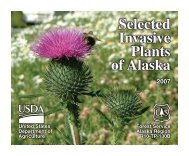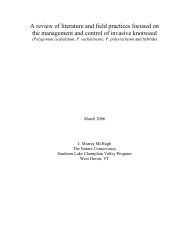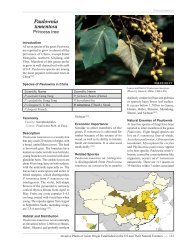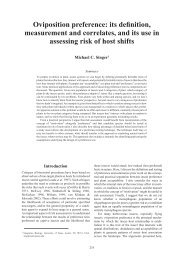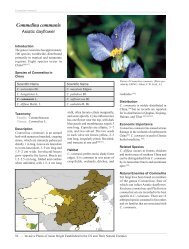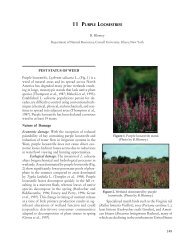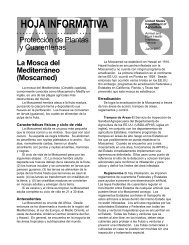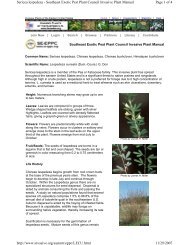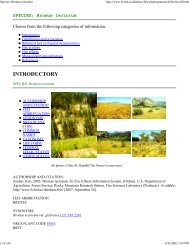Ailanthus altissima - Invasive.org
Ailanthus altissima - Invasive.org
Ailanthus altissima - Invasive.org
Create successful ePaper yourself
Turn your PDF publications into a flip-book with our unique Google optimized e-Paper software.
<strong>Ailanthus</strong> <strong>altissima</strong><br />
<strong>Ailanthus</strong> <strong>altissima</strong><br />
Tree of heaven<br />
Introduction<br />
The genus <strong>Ailanthus</strong> consists of<br />
approximately ten species, which<br />
have a wide distribution ranging from<br />
Asia to north Oceania. Five species<br />
and two varieties have been found in<br />
southwestern, southeastern, central,<br />
and northern China. [64]<br />
Taxonomy:<br />
Family: Simaroubaceae<br />
Genus: <strong>Ailanthus</strong> Desf.<br />
Species of <strong>Ailanthus</strong> in China<br />
<strong>Ailanthus</strong> <strong>altissima</strong> leaves and flowers. (Photo by David J. Moorhead, UGA.)<br />
Scientific Name<br />
Scientific Name<br />
A. <strong>altissima</strong> (Mill.) Swingle A. triphysa (Dennst.) Alston<br />
A. fordii Nooteboom A. vilmoriniana Dode<br />
A. giraldii Dode<br />
Description<br />
<strong>Ailanthus</strong> <strong>altissima</strong> is a deciduous<br />
woody tree that can reach a height of<br />
20 m. The bark is smooth with vertical<br />
streaks. The pithy shoots are initially<br />
covered with yellow or yellowish<br />
brown hairs, becoming glabrous. The<br />
leaves are odd-pinnate, 40-60 cm in<br />
length, consisting of 13-27 opposite<br />
or nearly opposite leaflets, which are<br />
papery, ovate, or lanceolate, 7-13 cm<br />
long and 2.5-4 cm wide, acuminate in<br />
the apex and suborbicular or cuneate<br />
at the base, with one or two glandular<br />
tips. The upper side of the leaf is deep<br />
green while the underside is grayish<br />
Colorful fruits of A. <strong>altissima</strong>. (Photo<br />
by Chuck Bargeron, UGA.)<br />
green. The inflorescence is a panicle<br />
with greenish flowers appearing from<br />
April to May. The flowers are about 6<br />
mm long with 5 imbricate sepals and<br />
five petals, which are 2-2.5 mm long<br />
and hirsute at the base. The staminate<br />
flowers have an unpleasant odor; leaves<br />
also produce this odor when bruised.<br />
The fruit, which appears from August<br />
to October, is an oblong samara, 3 -<br />
4.5 cm long and 1-1.2 cm wide, with<br />
a single flat seed in the middle of the<br />
wings [64] .<br />
Habitat<br />
A. <strong>altissima</strong> grows well in limestonerich<br />
soils and often occurs in disturbed<br />
areas.<br />
Distribution<br />
A. <strong>altissima</strong> occurs nationwide in<br />
China with the exception of Gansu,<br />
Heilongjiang, Hainan, Jilin, Ningxia,<br />
Qinghai, Tibet and Xinjiang. [64]<br />
The plant is recently reported to be<br />
cultivated in Ningxia, [115] Qinghai, [107]<br />
and Xinjiang. [175]<br />
10 — <strong>Invasive</strong> Plants of Asian Origin Established in the US and Their Natural Enemies<br />
Economic Importance<br />
A. <strong>altissima</strong> is planted in limestone<br />
areas for reforestation purposes, but<br />
in most cases, the plant is grown as<br />
an ornamental. The tree is a source of<br />
timber. The leaves serve as forage for<br />
Samia cynthia (Drurvy), a species of<br />
silk-producing caterpillar. The bark and<br />
fruit have medicinal uses [64] .<br />
Related Species<br />
Two varieties of A. <strong>altissima</strong> are<br />
reported in China. <strong>Ailanthus</strong> <strong>altissima</strong><br />
var. tanakai (Hayata) Kanehira et Sasaki<br />
has yellowish-gray bark, scythe-like<br />
leaflets and a single-seeded reddishbrown<br />
fruit. <strong>Ailanthus</strong> <strong>altissima</strong> var.<br />
sutchuenensis (Dode) Rehd. et Wils.<br />
can be identified by its red branchlets<br />
[64]<br />
.<br />
Natural Enemies of <strong>Ailanthus</strong><br />
At least 32 arthropods and 13 fungi<br />
have been recorded in association with<br />
the genus <strong>Ailanthus</strong> in China. Four<br />
identified fungal species (Phyllactinia<br />
ailanthi (Golov. et Bunk.), Cercospora<br />
glandulosa Ell. et Kell., Phyllosticta<br />
ailanthi Sacc., and Pseudocercospora<br />
ailanthicola (Patwardhan) Deighton;<br />
at least two new taxa (Alternaria<br />
ailanthi from Shandong and Shaanxi,<br />
and Aecidium ailanthi from Shaanxi);
<strong>Ailanthus</strong> <strong>altissima</strong><br />
along with one as yet unidentified<br />
Coleosporium sp. from Henan, are<br />
reported only from A. <strong>altissima</strong>.<br />
Cytospora ailanthi Berk. et Curtis,<br />
which can cause a symptom of bark<br />
canker on tree of heaven, is reported<br />
to occur in Xinjiang [187] .One flexuous<br />
filamentous virus has been isolated from<br />
a tree of heaven exhibiting mosaic. It<br />
has been identified as a member of the<br />
potyvirus group [181] . Witches’ broom,<br />
caused by a mycoplasma-like <strong>org</strong>anism,<br />
is reported from Anhui [187] .Two weevils,<br />
Eucryptorrhynchus brandti (Harold)<br />
and Eucryptorrhynchus chinensis<br />
(Olivier), and one bug, Orthopagus<br />
lunulifer Uhler, may have potential<br />
for biological control of this plant<br />
based on their reported H. R.s and<br />
damage to the plant.<br />
Fungi<br />
Phylum Family Species H.R. Ref.<br />
Ascomycota<br />
Basidiomycota<br />
Erysiphaceae<br />
Phyllactinia ailanthi (Golovin & Bunkina) Y.N. Yu<br />
& S.J. Han<br />
Uncinula delavayi Pat.<br />
m 22<br />
p 23 †<br />
o 22<br />
o 23<br />
Uncinula picrasmae Homma mo 22<br />
Coleosporiaceae Coleosporium sp. m 187<br />
Incertae sedis Aecidium ailanthi J.Y. Zhuang m 210<br />
Schizophyllaceae Schizophyllum multifidum (Batsch) Fr. oo 23<br />
Sphaerophragmiaceae Nyssopsora cedrelae (Hori) Tranzschel p 23<br />
Anamorphic Guignardia Phyllosticta ailanthi Sacc. m 23<br />
Anamorphic Lewia Alternaria ailanthi T.Y. Zhang & Y.L. Guo m nc<br />
Anamorphic Mycosphaerella<br />
Cercospora glandulosa Ellis & Kellerm. m 23<br />
Pseudocercospora ailanthicola (Patw.) Deighton m 110<br />
Pseudocercospora qinlingensis Y.L. Guo oo 110<br />
Anamorphic Valsa Cytospora ailanthi Berk. & M.A. Curtis m 187<br />
†<br />
recorded as Phyllactinia corylea (Pers.) P. Karst., and regarded as a synonym of Phyllactinia ailanthi (Golovin & Bunkina) Y.N. Yu<br />
& S.J. In reference 22, although Phyllactinia guttata (Wallr.) Lév. is regarded as the current name of P. corylea.<br />
<strong>Invasive</strong> Plants of Asian Origin Established in the US and Their Natural Enemies — 11
<strong>Ailanthus</strong> <strong>altissima</strong><br />
Arthropods<br />
Order Family Species H. R. Ref.<br />
Tetranychus urticae (Koch) p 85<br />
Acariformes Tetranychidae<br />
Tetranychus viennensis Zacher p 85<br />
Acalolepta degener (Bates) p 85<br />
Cerambycidae<br />
Mesosa longipennis Bates p 9<br />
Chrysomelidae Gastrolina depressa Baly p 85<br />
Alcidodes waltoni (Bohemen) p 85<br />
Desmidophorus hebes Fabricius p 85<br />
Coleoptera Curculionidae<br />
Eucryptorrhynchus brandti (Harold) m 2<br />
Eucryptorrhynchus chinensis (Olivier) m 2<br />
Eumolpidae Basilepta ruficolle (Jacoby) p 85<br />
Xyleborus discolor Blandford p 182<br />
Scolytidae<br />
Xyleborus lewisi Blandford p 182<br />
Erthesina fullo (Thunberg) p 85<br />
Hemiptera Pentatomidae<br />
Palomena angulosa Motschulsky p 85<br />
Cicadidae Huechys sanguinea De Geer p 85<br />
Coccidae Ceroplastes japonicus Green p 85<br />
Diaspididae Pinnaspis theae (Maskell) p 85<br />
Homoptera Dictyopharidae Orthopagus lunulifer Uhler m 85<br />
p 140<br />
Fulgoridae Lycorma delicatula (White)<br />
p 204<br />
Margarodidae Icerya seychellarum (Westwood) p 85<br />
Lepidoptera<br />
Geometridae<br />
Hepialidae<br />
Noctuidae<br />
Pieridae<br />
Pyralidae<br />
Saturniidae<br />
Culcula panterinaria (Bremer et Grey) p 85<br />
p 65<br />
Percnia giraffata (Guenée)<br />
p 158<br />
Phassus excrescens Butler p 85<br />
Phassus miniatus Chu et Wang p 85<br />
p 65<br />
Eligma narcissus (Cramer)<br />
m 85<br />
p 158<br />
Eurema hecabe (Linnaeus) p 85<br />
Talbotia naganuvm (Moore) p 158<br />
Dichocrocis punctiferalis (Guenée) p 85<br />
Omphisa plagialis Wileman p 85<br />
Actias selene ningpoana Felder p 141<br />
p 65 I<br />
Samia cynthia (Drurvy)<br />
Samia cynthia ricina (Donovan)<br />
p 141 II<br />
p<br />
158 III<br />
p 207<br />
p 158 IV<br />
p 207<br />
I , III<br />
Recorded as Philosamia cynthia walkeri Felder et Felder; II Recorded as Philosamia cynthia Walker et Felder, IV Recorded as Philosamia cynthia<br />
ricina Donovan<br />
12 — <strong>Invasive</strong> Plants of Asian Origin Established in the US and Their Natural Enemies




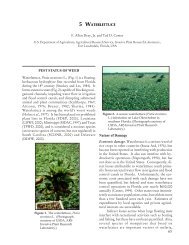

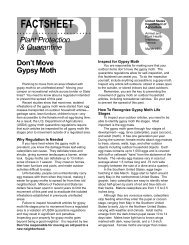
![A Guide to the Control and Management of Invasive Phragmites [PDF]](https://img.yumpu.com/27321025/1/190x190/a-guide-to-the-control-and-management-of-invasive-phragmites-pdf.jpg?quality=85)
